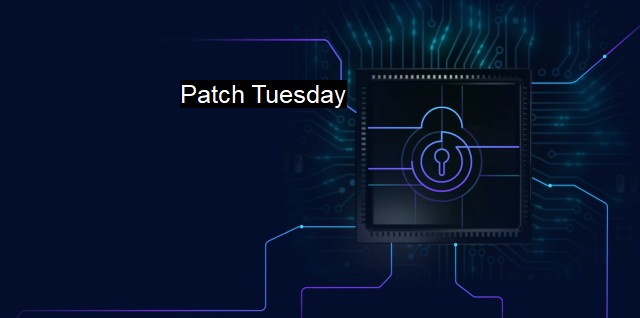What is Patch Tuesday?
Critical Updates and Security Fixes: Understanding the Importance of Patch Tuesday in Cybersecurity
"Patch Tuesday" is a commonly recognized moniker in the realms of cybersecurity and antivirus that stands for a specific day each month when various software companies, especially Microsoft, traditionally release security patches for their products. Established, adopted, and popularized by Microsoft, the term "Patch Tuesday" refers specifically to the second Tuesday of each month. This widely accepted practice in the domain of cybersecurity is designed to protect operating systems and software applications from potential threats.To place "Patch Tuesday" in context, it would be beneficial first to grasp the concept of security vulnerabilities and how they bear relevance to cybersecurity. In layman's terms, a vulnerability can represent a weakness or gap in a security system that could be exploited by cybercriminals. Widely used software, like Microsoft Windows or even antivirus programs, are basically multitudes of code lines. These codes, sometimes, encompass weaknesses that weren't observed during testing phases, and once the product is launched, these weak spots can potentially be uncovered by malicious users to compromise the system's security.
Because software products are highly complex, a continuous cycle of finding and fixing vulnerabilities is frequently inevitable. This is where patching comes into the picture. A patch is a piece of software designed to update, fix, or improve a computer program comprehensively, including fixing its security vulnerabilities. the release of these patches could potentially cause disruptions as they often demand system reboots to take effect. To mitigate this disruption, software firms began consolidating their updates and releasing them together on a prearranged day.
Patch Tuesday was a concept devised by Microsoft in 2003 as a part of its Trustworthy Computing initiative. Before Patch Tuesday was implemented, Microsoft would release patches sporadically without a predictable schedule. This approach proved to be problematic for IT professionals, and potentially debilitating for companies relying heavily on Microsoft software. Software administrators had to always be prepared for the possibility of new patches, and adapt their systems accordingly each time.
By creating a more predictable timetable with Patch Tuesday, Microsoft has rendered the process more streamlined for organizations globally. IT professionals now have a set schedule to prepare their systems for potentially disruptive updates. What's more, this strategy provides companies with the necessary timeframe to test patches in an insulated environment prior to their system-wide deployment, diminishing the risks of incompatibility or unexpected negative impacts on the systems.
As cybersecurity threats increase by the day, Patch Tuesday has become a significant occasion for companies to fortify their defense against cyber-attacks. This isn't just for Microsoft; several other software providers, such as Adobe, Oracle, and SAP, are now following a similar approach by providing monthly security updates.
It is important to note that despite having a structured plan for regular updates, Microsoft and other companies also issue emergency patches at unscheduled times for exceptionally critical vulnerabilities that require immediate remedy.
Consequently, Patch Tuesday is not merely a ritualistic update event, but the embodiment of a mindset focused on proactively addressing the continuously evolving landscape of cybersecurity threats. It reinforces the software companies' commitment to the security of their clients, all while simultaneously alleviating much of the unpredictability associated with vulnerability patching for IT teams across the world.
In the age of cyber threats, maintaining updated software is no longer a luxury—it's a necessity for safeguarding data and avoiding potentially devastating attacks. This understanding fosters and sustains the impact of Patch Tuesday in the ever-growing world of cybersecurity and antivirus approaches. Subsequently, as we continue to immerse ourselves in this digital-dominated era, the significance and necessity for practices like Patch Tuesday will only magnify even further, and perhaps set the precedent for more comprehensive measures to tackle rising cybersecurity threats.

Patch Tuesday FAQs
What is Patch Tuesday and why is it important for cybersecurity?
Patch Tuesday is a term used to refer to the second Tuesday of every month when Microsoft releases security patches for its operating systems, software, and other products. These updates are critical for maintaining the security of your system and protecting against potential cyber-attacks.How do I know if my system needs a patch?
You can check for available updates by accessing the Windows Update feature on your computer. The updates are automatically downloaded and installed if you have enabled that feature. You can also check for updates manually by visiting the Microsoft website or following the instructions provided by your antivirus program.What happens if I don't install the patches on Patch Tuesday?
If you don't install the patches on Patch Tuesday or as soon as possible after their release, your system becomes vulnerable to cybersecurity threats. Cybercriminals are always on the lookout for vulnerabilities in software, and an unpatched system is an easy target for them to exploit.Is Patch Tuesday only for Microsoft products?
No, Patch Tuesday is primarily associated with Microsoft products, but other software vendors also release monthly patches to fix security flaws in their products. Antivirus programs and other security software also release updates regularly to protect against the latest threats. It's crucial to keep all your software updated with the latest security patches to minimize the risk of cyber-attacks.| | A | | | B | | | C | | | D | | | E | | | F | | | G | | | H | | | I | | | J | | | K | | | L | | | M | |
| | N | | | O | | | P | | | Q | | | R | | | S | | | T | | | U | | | V | | | W | | | X | | | Y | | | Z | |
| | 1 | | | 2 | | | 3 | | | 4 | | | 7 | | | 8 | | |||||||